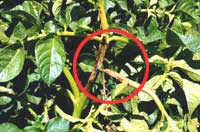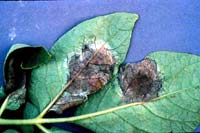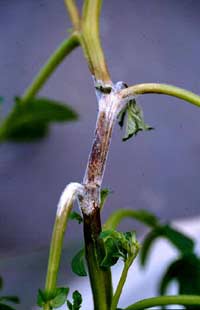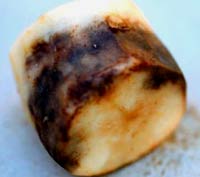Black Heart
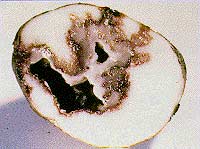 |
- The black-heart of potato is a non-parasitic
disease commonly found in storage godowns.
- This is due to high storage temperature and
low oxygen supply.
|
- Due to high temperature the tissues break down, resulting in high respiration and failure of gas-exchange.
- The net result is that the tubers are spoiled.
- If the affected tubers are cut to examine the cut surface turns pink, then dark brown to black.
- No microbial agent is associated with the disease.
- Providing sufficient aeration and storing the tubers in thin layers on racks help to avoid the damage.
 Top Top
Brown rot
- There are two major bacterial diseases of potato which are destructive, causing vascular infections.
- They are (i) ring rot caused by Corynebacterium sepedonicum (Spick & Kotth.) Skapt. And Bink. And (ii) brown rot caused by Pseudomonas solanacearum IE.F. Sm.
- Only the brown rot has been reported from different parts of India, whereas the ring rot is absent.
- The latter causes extensive damage to the potato crop in the United States of America and the former is most serious in many parts of Europe and tropical and sub-tropical regions of the world.
- The bacterium infects many hosts other than potato, important among which are tomato, brinjal and other solanaceous hosts.
- In India the disease is believed to have been prevalent since 1892 in Bombay, Poona and other places.
- At present it is widespread, occurring in most of the potato growing areas of the country and in some States it is endemic, causing heavy losses to the crop year after year.
Symptoms
- The first symptom of the disease in the field is dwarfing of the shoots accompanied by bronze discolouration of the leaves, followed soon by plant wilt. If the diseased plant is cut open a whitish bacterial ooze comes out of the cut ends of the stem.
- If the stem is split open and examined the vascular bundles will be seen discoloured black.
- Often such streaks are apparent through the skin on stem.
- If the tubers in the affected plants are examined, the eye-bud can be seen dark brown coloured and when cut open and examined, cream-like exudation may be seen coming from the cut surface of the tuber.
- The tubers may also rot in the soil, which is often associated with the attack of secondary soft rot bacteria.
Causal organism : Pseudomonas solanacearum E.F.Smith
Division: Bacteria
Order: Pseudomonadales
Family: Pseudomonadaceae
- The bacterium is a topic rod with bipolar flagella.
- In culture media the colonies are yellowish green and produce soluble fluorescent pigment.
- Some workers have reported on the prevalence of several strains in India and a few varieties of the bacterial species.
Disease cycle
- The organism persists in soil for more than 12 months.
- It may live saprophytically on plant residues
or in the tubers left over in the field.
- It can also perpetuate through diseased tubers
when used as seed material.
- When diseased tubers in a lot of seed material
are cut with a knife before planting, the cutting
knife spreads the bacteria to healthy tubers.
- In the field the infection may take place through
incidental wounds caused to the plants at the time
of various cultural operations.
- The bacteria may spread in the field through irrigation
and rainwaters, implements and tools, and by various
other means.
- The disease is favoured by high temperature and
high soil moisture.
Control
- The disease can be checked by selecting disease-free
seed tubers and by adopting various field sanitation
measures.
- A crop rotation to avoid potato, tomato and egg
plant in the field for not less than two and preferably
three years would help in starving out the pathogen.
- Varieties which are known to be resistant or tolerant
to the disease should be grown.
 Top Top
Early Blight
- This is one of the common diseases of potato and is world-wide in its distribution.
- In India it is found on potato crops grown in the hills as well as in the plains.
- Since the disease appears early in the season it is known as early blight, in contrast to Phytophthera infestans which appears late in the season, to cause blighting of the foliage.
- The early blight disease is also common on tomato in many parts of India and the causal organism is the same on both hosts.
Symptoms
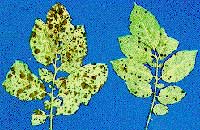 |
- On the leaves, spots of varying size appear.
- The spots
are irregular, brown to dark brown in colour, and
with concentric lines inside the spots.
|
- Often several spots coalesce to form large patches, resulting in the leaf blight.
- In severe cases the entire foliage is blighted.
- Though the fungus is mostly confined to the leaves, sometimes it may affect the tubers near the soil surface, causing brown discolouration and dry rot and at times affecting the stem and leaf petiole to cause slightly sunken, dark coloured, linear lesions.
- The tuber infection is carried to the storage godowns where it may spread to cause storage-rot, resulting in considerable damage.
Causal organism : Alternaria solani (Ell. & Mart.) Jones &
Grout.
Class:
Deuteromycotina
Order: Moniliales
Family: Dematiaceae
- The fungus produces a freely branching, light brown coloured septet mycelium.
- It spreads both inter- and intra-cellularly in the host tissue.
- The conidiophores are light brown, separate and measure 50-90 x 8-0 unit (. The conidia are borne in chains at the tip of the conidiophore. They are club-shaped, marinate with 5 to 10 cross septa and 1 to 5 longitudinal septa and with long beaks.
- They measure 120-296 x 12-20 unit. (In culture media containing organic nitrogen the fungus produces a pinkish to yellowish-brown coloured pigment).
Disease cycle
- The pathogen is mostly air-borne and the primary source
of infection may be through tubers, though not much evidence
has been obtained to substantiate this.
- Collateral hosts such as tomato may also play a
significant role in the perpetuation and dissemination of
the fungus.
Control
- Fungicidal sprays, preferably with copper fungicides or
Zineb given at 15 day intervals effectively control the
disease.
- Since the same spray schedule controls late blight also,
it has become a regular practice among potato growers in
many tracts to spray the crop with copper fungicides at
least three or four times, starting from about six weeks
after planting.
 Top Top
Late blight
- This is one of the worst diseases of potato, which takes a heavy toll year after year in many countries.
- It created history in Europe by causing the widespread famine during 1845 and resulting in subsequent migration of people from Europe, especially from Ireland.
- In India it was mostly confined to the northern hills until a decade agro, since then it has been reported from the Gangetic plains of Uttar Pradesh, in parts of West Bengal, and in some parts of South India, including the Nilgiris, the Pulneys and southern Karnataka State.
Symptoms
- The disease first appears as water-soaked, light brown lesions on the leaf blade.
- If the climatic conditions are favourable with humid and cloudy weather these lesions spread fast over the entire leaflet and petiole.
- Characteristic lesions are roundish with concentric markings on the margin, and generally involve the leaf margin.
- The lesions which are dirty brown in the beginning soon turn black.
- If the infected leaves are examined closely, whitish growth of the fungus can be seen on the lower surface.
- The fungus tuber formed inside the soil causing dry rot and brown discolouration of the tissues.
- In wet soils the tuber may rot quickly, with soft rot bacteria associating with the fungus, at which time a watery ooze may be seen.
- The severely diseased plants wilt within a few days after the first symptoms are seen on the leaves and in the field the disease spreads like wild fire, causing severe damage to the crop yield.
Causal
organism : Phytophthera infestans
(Mont.) de Bary.
Class:
Oomycetes
Order: Peronosporales
Family: Pythiaceae
- The fungus is present both inter- and intra-cellularly in the host and spreads by freely branching, hyaline, coenocytic hyphae.
- It produces many branched sporangiophores which emerge in clusters through the stomata and bear the hyaline, thin-walled, lemon-shaped, papillae sporangia.
- These sporangia are spread through wind and germinate through germ tubes and cause further infections.
- As the disease advances the fungus produces the oospores.
- The oospores are thick walled and germinate to form sporangia inside of which the biciliate sporangiospores are formed.
- At least 18 races of the fungus have been differentiated in India.
- Besides P.infestans, P.parasitica Dustur, and P.himalayensis Duster are reported to be associated with this disease in the Himalayan ranges.
Disease cycle
- The primary infection of the plants is through infected
tubers.
- The numerous conidia produced on the host foliage spread
by wind and irrigation water and cause secondary infections,
sometimes resulting in epiphytotic outbreaks of the disease.
- Later on, with the advancement of the disease, the
sexual stage is formed resulting in the oospores, which can
survive adverse climatic conditions.
- When the fungus is present in soil it attacks the tubers
and hibernates therein.
- When the infection tuber is stored during the off-season
and used as seed material during the following season, the
fungus is returned to the soil and causes further
infections.
- Thus the disease cycle is maintained.
- There is, however, no evidence to show that the fungus
is capable of remaining saprophytically in soil for long
periods.
- On the other hand, the pathogen can infect several other
species of Solanum and tomato and such collateral
hosts may also play a role in perpetuation of the organism.
Control
- The disease can be controlled by adopting certain
prophylactic measures.
- Firstly, the seed material should be obtained from a
disease-free area.
- They should be examined carefully before planting and
also should be pre-treated by dipping in 1 per cent Bordeaux
mixture or other fungicides.
- The plants must be sprayed with copper fungicides.,
zineb or phenyl compound at 15 day intervals, starting from
about a month after planting until the crop matures.
- Ridomil at 7 kg/ha in combination with Dithane M-45 has
given encouraging results.
- Considerable work has been done in Europe and America to
evolve late blight-resistant varieties, utilising Solanum
demissum, a hexaploid wild species as one of the
parents, newer varieties have been obtained which show high
resistance to the disease.
- The Central Potato Research Station, Simla, has released
three varieties, ie., Kufri Kishan, Kufri Sindhuri and Kufri
Kuber, which are resistant to late blight.
 Top Top
Potato Eel Worm or Golden Nematode of Potato
- This is one of the worst diseases of potato in the world.
- It was first discovered in Germany in 1881 and in Scotland in 1913.
- Since then it has been reported from most parts of Europe, USA, USSR, Peru and other countries.
- In India its presence in some areas of the Nilgiri hills was reported during the 1960s.
- The causal agent, Globodera rostoechinensis is a cyst-forming nematode of the Family Heteroderidae and Order Tylenchoidea.
- The chief symptoms of nematode infection are stunted growth and unthrifty appearance of the plant.
- The foliage may become chlorotic, followed by premature yellowing and death of the outer leaves.
- The disease may appear in patches in a field, and several such patches may be seen.
- When the infected plants are pulled out and examined the roots are formed in bunches and in larger numbers than in healthy plants, and the root tips may appear blunt.
- The tubers formed on the diseased plants are smaller in size and lesser in number.
- The cysts which emerge on the roots of mature plants are conspicuous by the yellow to brown colour.
- The larval emergence of the nematode is stimulated by the potato roots.
- On hatching, the second-stage larva penetrates the root, just behind the root tip or where the lateral roots emerge.
- After migrating to some distance with its head in the cells of the pericycle the larva molts, and during the development of the third-stage larva the sexes are differentiated.
- Then the fourth-stage larva emerges after molting, during which stage the reproductive system gains access to the exterior by the formation of the vulva A gelatinous matrix is extorted around the posterior end of the female and inside this matrix an egg-sac, containing the eggs is formed.
- These eggs hatch when stimulated by the presence of suitable host roots.
- The nematode cysts may drop off into the soil where they may remain dormant for several years.
- They may also be carried on the tuber, and when such tubers are used as seed material the nematode becomes active.
- The population in soil can increase upto ten times when a potato or tomato crop is grown during one season.
- If these crops are grown repeatedly the eel worm builds up in large numbers and causes severe reduction in the yield.
- Soil temperature and seasonal conditions, however, exert a great influence on its activity.
- At present six pathotypes of the nematodes are recognized.
- The disease is avoided by selecting healthy tubers for planting.
- Since the nematode population in soil has a direct correlation with tuber yield, opportunities for the nematode to build up its population should not be provided.
- For this purpose a crop rotation to avoid potato and tomato in the soil for atleast two years should be adopted.
- Also when potato is grown, harvesting should be done carefully and efficiently so that the tubers are not left over in the soil in large numbers, since these would help the nematode to multiply.
- Certain potato varieties are reported to be highly resistant to the nematode infection and these should be grown wherever possible.
- Soil fumigants such as 'D-D' have been successfully used in England and USA to check the nematode population.
- In India strict quarantine measures to prevent spread of the nematode from the localized areas on the Nilgiris to the other potato growing tracts of the country are required.
- In the affected areas on the Nilgiris systematic rogueing and regular eradication work are required.
- Work on testing the cultivars of potato in India for resistance to the nematode is necessary.
 Top Top
The following are some other diseases of
importance affecting potato
- Leaf blotch: Cercospora concurs (Carp.) Sac.
- Black scurf: Corticium solani Board. & Galzin (Perfect stage); Rhizoctonia solani Kuhn (Imperfect stage).
- Charcoal rot: Macrophomina phaseolina
- Sclerotium rot: Corticium rolfsii Curzi (Perfect stage); Sclerotium rolfsii Sace.(Imperfect stage).
- Wilt: Verticillium sp.
- Dry rot: Fusarium oxysporum Schl.
- Scab: Streptomyces scabies(Thaxter) Waksman and Henrici.
- Powdery scab: Spongospora subterranean (Wall.) Johns.
- Blacklog: Erwinia carotovora (Jones) Holland.
- Black-heart: Non-parasitic
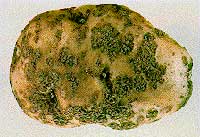
Scab
|
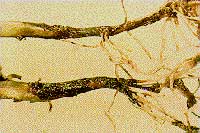
Blacklog
|
- The leaf blotch caused by Cercospora concurs is characterized by the appearance of roundish to irregular, pale-grey spots, which enlarge and coalesce to form blotches on the leaflets.
- The black scurf or Rhizoctonia rot of potato is caused by the imperfect stage of the fungus R.solani.
- Black sclerotial bodies are formed on the diseased tubers.
- The fungus also infects the stem to cause linear, dark lesions.
- The infected plants are killed and the tubers start rotting in the field, which continues in storage also.
- The same fungus affects several other plants and tubers causing wilt and dry rots.
- The silvery scurf of potato has recently been reported from the Nilgiris and Darjeeling.
- The symptoms are usually observed on the skin in the form of round, silvery spots of about 0.5 cm in diameter and they become clear when the tubers are washed well with water.
- Such spots enlarge and coalesce in storage and the tubers shrink and rot.
- Some varieties imported from Holland and Scotland have been found to be more susceptible to the disease than the locals.
- Since the fungus perpetuates in infected tubers the disease can be effectively controlled by avoiding seed tubers from affected areas and pretreating the seed with 0.2 per cent mercuric chloride before planting.
- The charcoal rot caused by Macrophomina phaseolina is characterized by darkened patches on the tubers, which later on become water-soaked and black.
- The infection takes place through the stolen and spreads to the tuber.
- The same fungus infects several vegetables and pulses.
- The plants affected by Sclerotium rolfsii appear yellowish and soon wilt. When the rot system is infected the roots turn black.
- The fungus affects the tubers also.
- The diseased stem and tubers carry numerous sclerotial bodies.
- This fungus affects other plants, including ornamentals and vegetables.
- The Verticillium wilt of potato is characterized by yellowing of the foliage, followed by browning and death of the plants.
- The fungus also infects the tubers, causing discolouration and decay.
- The scab of potato caused by Streptomyces scabies is worldwide in its distribution, including some places in India.
- It causes scabby outgrowths on the tuber and can survive in soil for many years to cause severe damage to the crop.
- The powdery scab caused by Spongospora subterranean also occurs in some places in India, but only to a limited scale.
- In other countries it causes extensive damage to the tubers, causing dry rot.
- The entire tuber is invaded, and fungus produces masses of powdery spores; hence, the name powdery scab.
- When the dry rot of the tubers is carried to the storage godowns, it spreads and becomes severe.
- The backlog disease of potato caused by the soft rot bacterium Erwinia carotovora occurs in the field and in storage places.
- In the field the affected plants turn pale-green or yellow, and soon wilt.
- The affected hauls are jet-black and shriveled at the soil level, and hence the name backlog disease.
- The tubers may also be infected by the bacteria entering through wounds.
Soon soft rot of the tuber starts, which continues in the storage godowns, spreading to other tubers through wound infections.
 Top Top
Viral diseases
- The potato crop in India is affected by as many as 25 virus diseases resulting in running outor deterioration in the quality of seed stock and resultant low yields of tubers.
- It is believed most of the viruses got introduced into India through the tubers imported from Europe and other places, where many virus diseases of the crop are prevalent.
- In India potato leaf roll, potato virus X, Y, S, G, streak, hairy sprout, spotted wilt and foliar necrosis viruses are important. The first two are more widespread than the others are.
Leaf Roll
 |
- The leaves roll upwards and inwards, sometimes showing a mild, diffuse mottling.
- The leaves may also become soft and drooping.
|
- Most of these symptoms vary considerably with the varieties, but the leaf roll symptom is characteristic in all the varieties.
- The virus can be transmitted through grafting, but the virus disease is perpetuated through virus laden tubers.
Mosaic
 |
- This virus is common on potato, tomato and other solanaceous hosts.
- The disease symptoms vary considerably with host plant and the crop variety.
|
- On the potato variety President, the chief symptom is a blotchy mottle, which becomes apparent about three weeks after planting.
- Such mottled mosaic symptoms are more pronounced on younger and newly formed leaves.
- Later necrosis appears on the veins on the under surface of the leaf, followed by similar lesions on the upper surface.
- These necrotic lesions spread along the veins to the petiole and stem.
- The affected leaves droop and wither.
- The entire plant becomes stunted and is easily identified even from a distance.
- The virus called Potato Virus Y is transmitted through seed tubers and obtaining disease-free tubers for planting is essential for checking the spread of the disease.
- Growing disease resistant varieties is also advocated.
- Besides the above three, other virus diseases of potato are of limited importance in some potato growing tracts of India.
- few mycoplasma diseases of potato are reported to occur in India. Purple top roll caused by mycoplasma induces chlorosis on younger leaves at the base, followed by rolling.
- The affected plants are stunted, display profuse axillary growth, nodal swelling with aerial tubers. Affected tubers develop hairy sprouts.
- The pathogen is transmitted by leafhoppers, Orosius albicintus and Alebroides nigroscutellatus.
- Marginal flavescence is prevalent in some potato growing regions.
- Developed of yellowing or chloroses on the margin of young leaves followed by the development of pink colour and leaf rolling are typical of stem and rachis is reduced, resulting in the bushy growth of plants.
- The mycoplasma is transmitted by Seriana equata and O.albicinctus.
- Witch's broom and potato pollody are two other mycoplasma diseases of potato, which reduce the yield of tuber.
 Top Top
|





